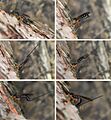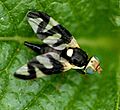Ovipositor facts for kids
An ovipositor is a special tube found on the back end of female insects and some other animals. It's like a tool they use to lay their eggs. This tube is made from three pairs of body parts that have joined together.
In many species of insects, the ovipositor is a sharp, piercing tool. This allows the female to place her eggs exactly where they need to be. For example, some types of wasps use their ovipositor to drill a hole into tree bark. Then, they lay their eggs inside the bodies of grubs (insect larvae) that are living under the bark.
However, in some insects like certain hymenoptera (which include wasps, bees, and ants), the female's ovipositor is used as a sting for defense. When used as a sting, it is not used for laying eggs.
How Insects Lay Eggs
The ovipositor is a very important part of an insect's reproduction process. It helps female insects make sure their eggs are safe and have the best chance to hatch.
Different Types of Ovipositors
Ovipositors come in many shapes and sizes, depending on the insect and how it lays its eggs.
- Some are long and thin, perfect for reaching deep into wood or soil.
- Others are short and strong, used for pushing eggs into tight spaces.
- Some can even be used to inject venom for defense, as mentioned before.
The design of an ovipositor is perfectly suited for each insect's lifestyle and where it chooses to lay its eggs.
Images for kids
-
The process of oviposition in Dolichomitus imperator: 1 Tapping with her antennae the wasp listens for the vibrations that indicate a host is present; 2 With the longer ovipositor, the wasp drills a hole through the bark; 3 The wasp inserts the ovipositor into the cavity which contains the host larva; 4 Making corrections; 5 and 6 Depositing eggs.
-
Ovipositor of long-horned grasshopper (the two cerci are also visible)
-
A female fly in the family Tephritidae, with the ovipositor retracted and only the scape showing.
See also
 In Spanish: Ovipositor para niños
In Spanish: Ovipositor para niños






